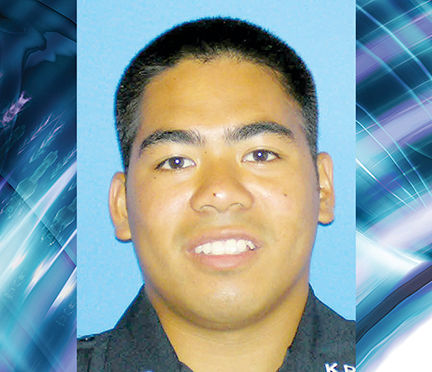LIHUE — Slow down. That’s what Kauai police officers do when approaching an emergency traffic accident and responding to the scene, according to testimony by one officer in court Tuesday. Two KPD officers and a civilian testified at an evidentiary
LIHUE — Slow down.
That’s what Kauai police officers do when approaching an emergency traffic accident and responding to the scene, according to testimony by one officer in court Tuesday.
Two KPD officers and a civilian testified at an evidentiary hearing for Irvin Magayanes, the officer charged with negligent homicide in the second degree in the death of Michael Kocher Jr., 19.
Fifth Circuit Court Judge Randal Valenciano denied the defense’s motion to dismiss felony information. He said speeding wasn’t the negligent act, but the failure to slow down was the “interesting issue” the state would need to address at trial.
Magayanes is charged with hitting Kocher with his car on Jan. 3 on Kaumualii Highway while responding to the scene of a previous accident where Kocher had just been hit by another vehicle.
KPD officer Arthur Styan, who responded to the accident that night, testified it was customary for officers to speed when responding to an emergency traffic accident and getting to a scene quickly is “to prevent any further accidents and possible injuries.”
He said he was coming from Hanapepe and based on KPD dispatch communications, he understood the accident to be near the Kaumakani overpass by the school. Styan said he did not observe any flashing lights before arriving at the overpass.
“As you approached the Kaumakani School, what was your speed in relation to the posted speed?” said Defense Attorney Craig De Costa.
“I was probably 10 to 15 miles over,” Styan said.
“And as you approached the area near the school where you believed the accident had occurred, what did you do?” De Costa said.
“I slowed my speed down as I got near the area where I thought the accident was,” Styan said.
Styan then parked ahead of the accident, turned his lights on to notify people of the accident and blocked the westbound lane, according to his testimony.
Prosecuting Attorney Justin Kollar asked Styan to clarify why he would slow down before arriving at the scene of an accident.
“When you were approaching the scene of where you think an accident took place, you slow down, right?” Kollar said.
“Yes,” Styan said.
“To avoid making anything worse, right?” Kollar said.
“Correct,” Styan said.
Styan said several conditions such as traffic and the severity of the crime or incident determine how fast he’ll drive in an emergency situation.
That’s true of all officers, said KPD Police Chief Darryl Perry.
“Every emergency situation presents its own unique set of conditions that dictates response protocols with respect to activation of emergency equipment (lights and sirens), speeds, and other facts,” Chief Perry told The Garden Island. “Officers responding to emergencies must take these variables into consideration and act appropriately given the totality of circumstances.”
Defense Attorney Daniel Hempey asked KPD Officer Shawn Hanna, an investigator with KPD’s Traffic Safety Section, if he had exceeded the speed limit when he responded to the scene on Jan. 3. Hanna said he had.
It’s estimated Magayanes was going about 70 mph when he struck Kocher. The posted speed limit where the accident took place is 50 mph.
Hanna said exceeding the speed limit was a common practice of KPD in responding to accidents to “mitigate the on-scene emergencies, to be there to protect other first responders and preserve the scene.”
Questions remain over where the accident took place.
Sources close to the investigation said the accident was somewhere between mile marker 19 and 20 on Kaumualii Highway.
Magayanes was the first officer to respond to the scene on the night of Jan. 3 after 9:30 p.m. on an unlit highway.
In its argument, the state said “Kocher was walking in the roadway under an overpass that was a chokepoint and did not have a shoulder to walk on” when he was hit by a civilian who was not charged in this case.
In Hanna’s testimony, he said the shoulder gets a few feet wide and that there was no obstructions on it. He concluded that Kocher must have been walking in the middle of the highway and that the accident did not even occur at the overpass or anywhere near the chokepoint.
According to his testimony, the accident occurred just west of the beginning of a guardrail.
“Did this chokepoint have anything to do with this crash in your estimation?” Hempey said.
“No,” Hanna said.
Since the incident, Magayanes has been on administrative desk assignment.
The state will have the opportunity to present itscase before a jury on Jan. 11.
Members of Kocher’s family and friends filled the courtroom.
His mother, Patricia Kocher, began video recording the testimony from one of the officers with her phone. As the bailiff saw her, her phone was confiscated and the recording deleted.
The entire family was asked to leave the courtroom.
Once the proceeding was over, Judge Valenciano addressed the court and asked parties from both sides to “control their support.”
“I know this is a sensitive case and I know this is a high-profile case, but that doesn’t mean that the parties can come in and tape record this proceeding,” he said. “That is totally inappropriate and not allowed.”


